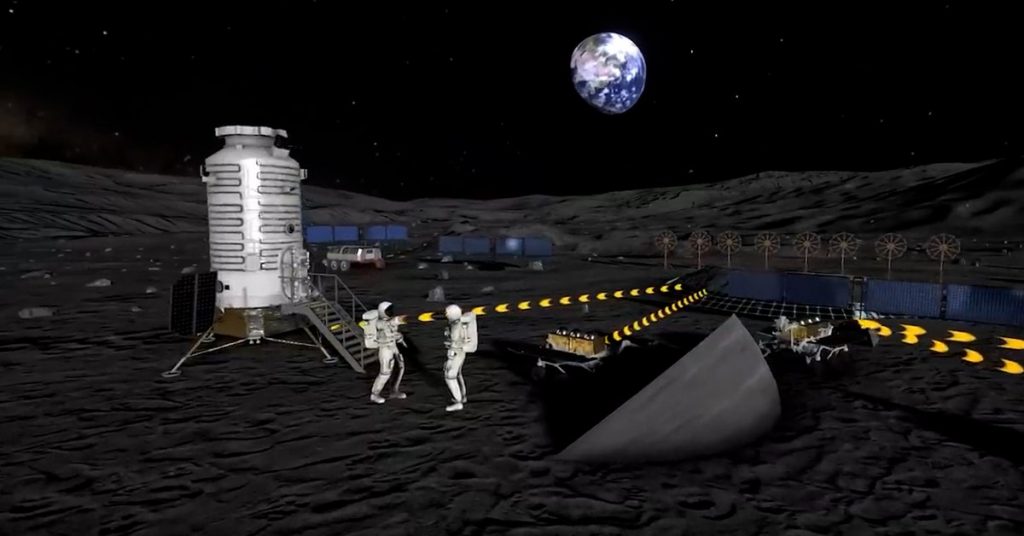Video: China and Russia revealed how the lunar station will be ready by 2035

On Wednesday, China and Russia unveiled a roadmap to build The International Lunar Research Station (ILRS) which they intend to equip by 2035 And promises to open a A new chapter in space exploration and research
Chinese and Russian space officials revealed their plans at a conference Global Space Exploration (GLEX) in Saint Petersburg, Russia, indicating that the ILRS has received interest many countries s organizations.
ILRS is to be operated in conjunction with, but separately from, the lunar exploration programme Artemis from the United States.
:quality(85)/cloudfront-us-east-1.images.arcpublishing.com/infobae/M3NHHXGE25FKDF6PDOAKGAIXKU.jpg 420w,https://www.infobae.com/new-resizer/aqL7OYnCu8jPIarhw80--Vi5qD4=/768x432/filters:format(jpg):quality(85)/cloudfront-us-east-1.images.arcpublishing.com/infobae/M3NHHXGE25FKDF6PDOAKGAIXKU.jpg 768w,https://www.infobae.com/new-resizer/OHjJfYQg_It1ZPAES80Eon3fPcU=/992x558/filters:format(jpg):quality(85)/cloudfront-us-east-1.images.arcpublishing.com/infobae/M3NHHXGE25FKDF6PDOAKGAIXKU.jpg 992w,https://www.infobae.com/new-resizer/N8Q-iZ4xGandibDtYn_N_cPQxNY=/1200x675/filters:format(jpg):quality(85)/cloudfront-us-east-1.images.arcpublishing.com/infobae/M3NHHXGE25FKDF6PDOAKGAIXKU.jpg 1200w)
Wu Yanhua, deputy director of the China National Space Administration (CNSA), presented the scientific objectives, Facilities, transportation, infrastructure on the moon, stages of development and cooperation frameworks for the company.
The first phase of the ILRS, designated as a survey, involves data collection and verification HD soft landing In 2021-25 with Chinese missions Chang’e 4, 6, 7, Luna 25, 26 and 27 from Russia and potential partner missions.
second stage ofConstruction “consists of two phases (2026-30, 2031-35). The first includes technological checks, sample returns, bulk cargo delivery, and start of joint operations. Planned missions are Chang’e-8 and Luna 28 and potential international contributions.
The second phase seeks to complement in-orbit and surface infrastructure for energy, communications, on-site resource use, and other technologies. The so-called ILRS-1 through 5 missions, respectively, will focus on energy and communications, research and exploration facilities, on-site resource use, general technologies, and astronomical capabilities. Russian heavy payload launch vehicles are listed for mission launching.
:quality(85)/cloudfront-us-east-1.images.arcpublishing.com/infobae/ST6N5W5QDZHNBONGTULZY5A3GU.jpg 420w,https://www.infobae.com/new-resizer/DpDIajwDiYpr8S1IteyTS9QJe-w=/768x432/filters:format(jpg):quality(85)/cloudfront-us-east-1.images.arcpublishing.com/infobae/ST6N5W5QDZHNBONGTULZY5A3GU.jpg 768w,https://www.infobae.com/new-resizer/iJW_BQxhfEuNLsPPU4Y7WmkzKgQ=/992x558/filters:format(jpg):quality(85)/cloudfront-us-east-1.images.arcpublishing.com/infobae/ST6N5W5QDZHNBONGTULZY5A3GU.jpg 992w,https://www.infobae.com/new-resizer/sVBo-VC6DdIoJBcHVyLG-rhtchY=/1200x675/filters:format(jpg):quality(85)/cloudfront-us-east-1.images.arcpublishing.com/infobae/ST6N5W5QDZHNBONGTULZY5A3GU.jpg 1200w)
The final “use” phase after 2036 will see the start of manned landings. Then, CNSA posted English and Chinese versions of the roadmap on its web pages, while Roscomcos shared a presentation video on Twitter.
The spacecraft shown in the video includes orbiters and satellites, Descent and ascent vehiclesand the surface infrastructure of Energy, communications, jumping robots and smart mobile vehicles.
The ILRS has not yet been located. Possible destinations identified in the presentation were Aristarchus Crater, Marius Hills in the northwest of the Moon’s near side, and Amundsen Crater near the South Pole.
It is . said Sergey Savelyev, Deputy Director General for International Cooperation at Roscosmos “It is difficult to overestimate the scientific significance of the project.”
Russia and China signed a memorandum of understanding on ILRS in March. International partners were publicly invited on the sidelines of the meetings of the Scientific and Technical Subcommittee of the United Nations Committee on the Peaceful Uses of Outer Space (COBOS) on April 23.
China and Russia have presented five areas of cooperation in which potential partners can cooperate. Wu said the parties hope to release a legal document detailing the ILRS principles before the end of the year.
:quality(85)/cloudfront-us-east-1.images.arcpublishing.com/infobae/5JQHWFTIM5HT7D2Q4L3SHB4DFA.jpg 420w,https://www.infobae.com/new-resizer/-hJ3qthtJIKj1ZhX5mGLmbjV6Lg=/768x432/filters:format(jpg):quality(85)/cloudfront-us-east-1.images.arcpublishing.com/infobae/5JQHWFTIM5HT7D2Q4L3SHB4DFA.jpg 768w,https://www.infobae.com/new-resizer/uXEXtTj2mxhdvC6VOers-I7mgv8=/992x558/filters:format(jpg):quality(85)/cloudfront-us-east-1.images.arcpublishing.com/infobae/5JQHWFTIM5HT7D2Q4L3SHB4DFA.jpg 992w,https://www.infobae.com/new-resizer/V81ke4fGGNbS97Zg-zoSs2tAP64=/1200x675/filters:format(jpg):quality(85)/cloudfront-us-east-1.images.arcpublishing.com/infobae/5JQHWFTIM5HT7D2Q4L3SHB4DFA.jpg 1200w)
Savelyev Wu said talks have been held with the European Space Agency and the French Center for Space Studies, while Thailand, Saudi Arabia and the United Arab Emirates have expressed interest in the project. However, Wu noted that the discussions are at a very early stage.
Then the development came Brazil became the twelfth country to join the Artemis Accords, the US-led effort to establish Code of conduct for space exploration.
Marco Liberti, resident member of the European Institute for Space Policy in Austria, said: space news that the development of ILRS “It signals the gradual splitting of the international space community over two opposing, and possibly opposing, paths to future lunar exploration activities.”
:quality(85)/cloudfront-us-east-1.images.arcpublishing.com/infobae/A7CVOCMMONHDTMVIIST4BR4BYI.jpg 420w,https://www.infobae.com/new-resizer/NwLOi6EVE7vX8FnShgDXa5KmPqA=/768x432/filters:format(jpg):quality(85)/cloudfront-us-east-1.images.arcpublishing.com/infobae/A7CVOCMMONHDTMVIIST4BR4BYI.jpg 768w,https://www.infobae.com/new-resizer/Bwh9_jLHJ5d0xxOVdpGLUy2_aW0=/992x558/filters:format(jpg):quality(85)/cloudfront-us-east-1.images.arcpublishing.com/infobae/A7CVOCMMONHDTMVIIST4BR4BYI.jpg 992w,https://www.infobae.com/new-resizer/nvdXlofjDyOTqX5nRYKYlkGX6aA=/1200x675/filters:format(jpg):quality(85)/cloudfront-us-east-1.images.arcpublishing.com/infobae/A7CVOCMMONHDTMVIIST4BR4BYI.jpg 1200w)
“Certainly, like the Artemis program, the lunar base project envisioned by China and Russia has been deliberately opened up to international partners at all levels. Even if participation in Artemis, led by the United States, does not itself rule out potential participation in ILRS, the truth is that the two projects are largely mutually exclusive in terms of partnership configurations. he added.
Read on

“Future teen idol. Hardcore twitter trailblazer. Infuriatingly humble travel evangelist.”




:quality(85)/cloudfront-us-east-1.images.arcpublishing.com/infobae/BNGH73UCKQAZSQPCODUWO2BE5Y.jpg)





